| |
|
|
|
Cold Mountain
|
The first film to feature singing from the Sacred Harp
tradition
See also the Video clips
here.
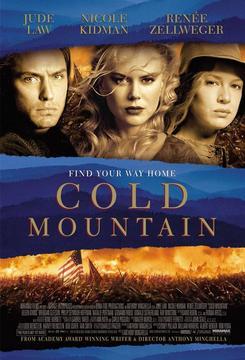
-
-
by Mick Verrier
Cold Mountain
has been awaited with eager anticipation in shape-note singing circles,
ever since the news broke that Tim Eriksen was involved in the music and
had managed to bring Sacred Harp singing into the film. There seemed to
be a widespread expectation that Cold Mountain would do
for Sacred Harp what O Brother, Where Art Thou? had done
for bluegrass. The film went on general release in the US a few weeks
ago and, thus far, the reaction of the US Sacred Harp community is,
perhaps, best summed up as appreciative but disappointed.
Cold Mountain
opened here in the UK at Christmas and I saw it in Birmingham on
December 27th, with Isabelle Walker. We tried to prepare
ourselves for disappointment (musically at least) by telling ourselves
that we were going to see a film, not to listen to music; in the
event, we found ourselves far from disappointed. The film held our
attention from beginning to end (two-and-a-half hours), and the fact
that we recognised songs and tunes in the score simply added to our
enjoyment.
Set against the background of the American
Civil War, Cold Mountain is based upon a novel of the same
name, and manages to include most of the strands and events from the
book, though not in quite the same order. Of course, comparing a film to
its stimulus is rarely productive, as the constraints are totally
different, but on the whole this film does justice to its book: it
skilfully weaves together two (or three or four, depending on your point
of view) storylines without confusion.
As is
often the case with a film over two hours long, there is a danger that
the audience might lose patience with the principal leads, Ada (Nicole
Kidman) and Inman (Jude Law), but a new character, Ruby (Renee Zellweger),
is introduced just in the nick of time, to give Ada, and the film, a
well needed shot in the arm. Music is a constant theme throughout the
film, from Ada's piano to the proto-old-time music supplied by Ruby's
father (voiced by Tim Eriksen) and his companions, and, of course, the
Sacred Harp contributions.
Many from the US shape note community
who have commented on the film have raised concerns about the level of
violence and a certain amount of 'adult' content, but I have to say that
I was not worried on either score. The film opens with a very down to
earth and gritty battle sequence, heavy with realistic violence but not
in the Saving Private Ryan league, but for shape note
singers the main point of interest is the musical underscoring: 'Idumea'.
Unfortunately, the battle is very loud, and the song is very low in the
mix, so one cannot really hear the words, which is a shame. Some
orchestral accompaniment has been added which, perhaps strangely, does
not detract in any way from the song (and which does not feature on the
soundtrack CD). As to the adult content, it is mostly very brief and not
particularly offensive, or at least it wasn't when we saw it, which may
mean that the BBFC has insisted upon some editing.
After its loud and violent beginning,
the film settles down to become a touching story which will keep you
thoroughly gripped until the final scenes of tragedy and hope, but I
wouldn�t want to give the game away ... suffice it to say that it is a
film worth seeing, music or no music.
However, for most of you reading
this review, it will be the music that you want to hear about, and
the question of whether or not the film will lead to an upsurge in
interest in shape note singing: the answer to that question, put
bluntly, is that it will not. 'Idumea' will have real meaning only for
the small minority of viewers who actually know the song.
'I'm Going Home' appears in the
context of a shape note singing, but that context is not explained
anywhere in the film and therefore it will only be apparent to those who
are already familiar with the concept.
'Wayfaring Stranger' is sung as
a folk song, with accompaniment, and is very effective in that form, but
has no outward connection to the shape note tradition at all in that
context. The simple truth, therefore, is that nothing in the film is
likely to spark much interest in what we, the shape note community, do.
There is talk of documentary material being included on the DVD release,
and certainly there is a possibility that someone buying the soundtrack
CD (where the Sacred Harp items are credited to 'Sacred Harp Singers at
Liberty Church') might realise that there is something interesting going
on, but the film itself will not have that effect.
Go and see it anyway!
Mick Verrier
Harwich
January 2002
|

|
|
|
 |
Shines Light on 'Sacred Harp' Music
|
|
By TARA BURGHART, Associated
Press Writer
CHICAGO - Surrounded by other singers
arranged in a square, Judy Hauff rocks her feet heel to toe,
rhythmically slashes the air with her arm and sings "Fa la sol la
sol."
This is "shape note" music, an a cappella, traditional form of folk
hymn singing that dates to Colonial times. Also known as Sacred Harp
music, it's enjoying a revival after being featured in the film "Cold
Mountain" and on its soundtrack.
"It's America's best kept musical secret," said Hauff at a recent
workshop at the Old Town School of Folk Music.
In the Civil War-era movie, which is nominated for seven Academy
Awards (news
-
web sites), the shape note song "Idumea" is played over a battle
scene. Another scene, in a church, features the characters singing
"I'm Going Home" from their Sacred Harp hymnals when they are
interrupted with news that the war has begun.
Sacred Harp uses printed shapes to help untrained singers read the
music. A triangle represents fa, a circle for sol, a square for la and
a diamond for mi. There is no musical accompaniment -- "harp" refers to
the most-used tune book, "The Sacred Harp," first published in 1844.
[Actually, the 'sacred harp' referred to was originally a
reference to the human voice - Ed.]
Also unique is the way singers are organized -- in an open square,
with tenors, bass, alto and treble voices each taking a side. Singers
take turns leading the group and beat [with] their hands to keep time.
The result is a loud, clear, almost astringent sound that some
describe as ancient, others like a human bagpipe or organ. Singers
usually perform a song using its notes before singing the lyrics. And
everyone is expected to participate -- there is no division between a
choir and audience.
"It's not for listening," said Tim Eriksen, who sings and appears
in "Cold Mountain" and who led the workshop in which Hauff
participated. "You can listen to it ... But the beauty of this really
comes in the singing."
Some Sacred Harp enthusiasts hope "Cold Mountain" will do for shape
note singing what the "O Brother, Where Art Thou?" soundtrack did for
bluegrass. Both soundtracks were produced by T Bone Burnett.
Eriksen's workshop was so popular that organizers rearranged the
room and expanded the class size from 35 to 80. In other cities,
long-established Sacred Harp groups are attracting new people. And
while only two Sacred Harp songs appear on the "Cold Mountain"
soundtrack, there is talk of releasing an entire CD filled with shape
note music from the "Cold Mountain" sessions.
The "Cold Mountain" shape note music for the soundtrack and movie
was recorded at Liberty Baptist Church on Alabama's Sand Mountain,
although bits of the stars' singing voices were later blended in.
Eriksen was hired to teach the actors how to sing shape note music
so that they would look realistic on film. His singing voice was also
dubbed in for that of a singing fiddler, and he appears on the
soundtrack and in the church scene leading the song.
A world music expert and former punk rocker from Massachusetts who
discovered shape note singing in his teens, Eriksen, 37, symbolizes
the variety of people the music attracts. And while the hymns are
Christian in nature, the performances are not outwardly religious.
Sacred Harp music was replaced in many parts of the country in the
second half of the 19th century by religious hymns. But it found a
permanent home in rural areas of the South, where "singing
conventions" cropped up and people would travel for miles to sing for
hours, or days, at a time.
About 20 years ago, Sacred Harp attracted new enthusiasts, many of
them curious participants on college campuses and in churches in New
England and the Midwest.
In Chicago, Hauff, 60, and Ted Johnson, 75, were part of a group of
about a dozen folk-music fans who discovered Sacred Harp music in the
early 1980s. Intrigued, they traveled to the South to learn from
people who had grown up singing the music.
"It just blew us away," Johnson remembered.
Now there are Sacred Harp groups across the nation and many
enthusiasts fly cross-country on weekends to join other groups.
Richard DeLong, who performed in the Liberty Baptist Church
recordings, hopes the new exposure will help keep Sacred Harp music
alive.
"We're delighted to welcome new people all the time," said DeLong,
who was taken to his first shape note singing as a baby by his
grandmother in rural Georgia. "It won't take them very long � if they
keep coming, they'll get hooked, just like the rest of us, and be part
of the extended musical family."
|
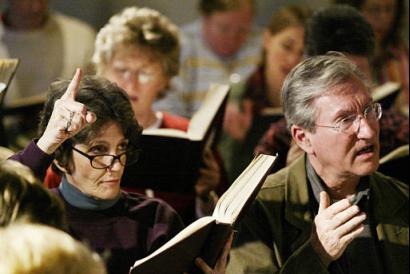 |
| Judy Hauff, left, of Chicago, and
Henry Schuman, of Ann Arbor, Mich., sing during a class on Sacred Harp
music at the Old Town School of Folk Music, Saturday, Jan. 10, 2004,
in Chicago. Sacred Harp music is a traditional American form of
singing folk-hymns that dates back to the early 1800s. (AP Photo/Brian
Kersey)
|
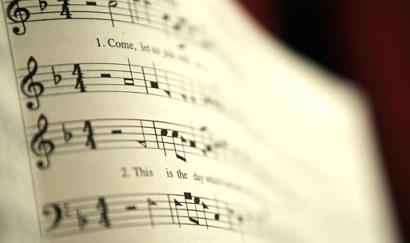 |
| Music from the 'The Sacred Harp'
contains notes of different shapes like squares and triangles setting
it apart from traditional music as shown in this illustration from the
Sacred Harp book at the Old Town School of Folk Music, Saturday, Jan.
10, 2004, in Chicago. The music was developed in the early 1800s, as a
way to help untrained singers read the music. (AP Photo/Brian Kersey)
|

'Cold Mountain'
shows off sacred singing
Shape-note genre could get a boost from hit
film
By Nancy Henderson Wurst
January 4th 2004
In a scene from "Cold Mountain," Ada and Inman
exchange glances from hard wooden pews as they sing from their "Sacred
Harp" hymnals. The congregation keeps time to the jubilant a cappella
tune, rigid hands slicing the air, strong voices lifted in praise.
When news of war interrupts the service, the male parishioners eagerly
file out of the church and the women continue to sing: "I'm glad that
I am born to die / From grief and woe my soul shall fly / And I don't
care to stay here long!"
Despite its heaven-bound theme, "I'm Going Home" is a ray of light in
a brutal film of survival, personal growth and enduring love. "It's
really a joyful song, and Anthony [Minghella, who directed the Miramax
film] wanted some brightness in there," says Tim Eriksen, a
Minneapolis-based musician who taught Nicole Kidman (Ada) and Jude Law
(Inman) how to sing Sacred Harp music. "There's considerable darkness
in the film. But in the church scene, there's white light streaming
in, and everybody's just really enjoying themselves singing."
Such is the nature of shape-note singing, a style
born in Colonial New England as a way for off-key congregations to
learn the hymns. By 1850, hundreds of songbooks relied on four
"shape-notes" (triangles, circles, squares and diamonds) instead of fa,
sol, la and mi. Over the years, however, the method all but
disappeared except in the rural South, and most of the tomes faded
into obscurity. "Sacred Harp," which contains more than 500 three- and
four-part fugues, hymns and marches, survived.
Shape-note revival
During the past two decades, a shape-note revival has been
infiltrating churches, college campuses and meeting houses in cities
across the U.S., including Chicago. And with the release of "Cold
Mountain," the revival is likely to receive renewed attention.
During a singing, altos, sopranos, basses and tenors sit facing each
other in a "hollow square" and take turns leading the group in a
favorite Sacred Harp song. On Jan. 11 the Chicago Sacred Harp Singers
will celebrate their 20th anniversary at an all-day singing at the
Irish American Heritage Center. The clan came together by accident,
after folk-music enthusiasts stumbled across a copy of the old
songbook.
"Eventually they figured out that there were actually people down
South who were singing this stuff, and it was called Sacred Harp,"
says Cathryn Baker, a librarian, University of Chicago music alumna,
and spokeswoman for the city's Sacred Harp movement. "So they went
South and realized that everything they had been doing was wrong. And
they came up here and changed their ways."
The practice gradually garnered a following. Today the mailing list
for the University of Chicago Shape-Note Singing Association (a loose
network of "officers" who organize events) includes 400 Sacred Harp
fans. Weekly singings are held at participants' homes in Hyde Park.
Monthly "all-Chicago" events take place on the North side of town,
most often at St. Paul's Community Church in Wicker Park.
Despite its Christian-based lyrics, the genre draws singers from all
types of professions and backgrounds: social workers, teachers, chefs,
retail executives, newspaper reporters. "There are even practicing
Jews who are part of Sacred Harp," says Baker, who joined the Hyde
Park singings about seven years ago. "There are Buddhists. There are
atheists. There are people like me; I'm a Quaker. There are Baptists.
And we all have different political persuasions."
T Bone Burnett, the Grammy-winning music director who produced the
soundtracks for "Cold Mountain" and "O Brother, Where Art Thou?"
admits he is "very new" to the genre, although he was aware of it
while growing up in North Carolina and Texas. The first time he heard
shape-note music, he says, "it sounded like something from another
planet or something, so beautiful and so strange."
While filming "Cold Mountain," Burnett and Minghella recorded nearly
40 Sacred Harp tunes at a small church in Henagar, Ala. (Eriksen, a
punk rocker, world-music expert and Sacred Harp tenor, talked the
directors into documenting a real singing instead of trying to
re-create one in the studio.)
"I don't think we ever had an idea of the size of the role it was
going to play," Burnett says. "We just recorded some to have as a
resource." Burnett was so pleased with the outcome that he plans to
release a compilation of the Alabama songs this spring. What's more,
Minghella was so smitten with the music that two of the songs, "I'm
Going Home" and "Idumea" (the score for the horrific battle scene at
Petersburg, Va.), became pivotal parts of the movie.
Taught technique to actors
Eriksen was hired as the singing voice of the "Cold Mountain" fiddler Stobrod Thewes, played by Brendan Gleeson, but was subsequently cast
as the choirmaster in the church scene and commissioned to teach the
actors and extras how to sing via shape-notes. Eriksen also sang or
arranged seven soundtrack cuts, including a solo rendition of "Idumea."
His infant son, Luka, even shows up in a scene with Renee Zellweger's
plucky character, Ruby.
On Saturday, Eriksen will conduct a Sacred Harp workshop at the Old
Town School of Folk Music and give a concert featuring selections from
"Cold Mountain," solo arrangements of Sacred Harp songs, and
traditional ballads on banjo, fiddle and guitar. Despite his eclectic
musical background -- he also performs popular Bosnian tunes with his
wife, Mirjana -- his favorite remains Sacred Harp.
"I love performing, but I really love singing with people," he says.
"If I had to choose, I would certainly choose to sing with people
rather than at them. It's much more fun."
Sacred Harp supporters are often wooed by the intense, soulful
harmonizing, which seems to fill every inch of the room. The first
time she heard the music, says Baker, "I felt like I wasn't even in my
skin anymore. It was like I was part of everybody there, and they were
all part of me, and we were all just one, big beautiful sound."
Baker and other shape-note aficionados are pleased that the genre is
gaining exposure via "Cold Mountain." But they're also concerned that
a sudden surge in popularity might taint the tradition and the
spiritual "community" of Sacred Harp singing.
"Like everybody else, I'm nervous," Baker
admits. "I'm worried that some of the glue that holds us together
might get thinned out, because there will be a number of people coming
in just out of curiosity and not because it means anything to them."
On the other hand, she says, "they will probably sift themselves out
because you can't just dip your toe in the water of Sacred Harp and
say, `Ooh, that's really nice' and expect it to really keep going with
any kind of fervor. You have to immerse yourself in it."
So is Sacred Harp destined to get the same boost from "Cold Mountain"
as old-time country music did from "O Brother"? Probably not, Burnett
says.
"I don't think it's a good idea to compare what might happen to
shape-note music to what happened in `O Brother, Where Art Thou?'" he
says. "That album started out with a chain-gang song recorded as
Southern heritage music in 1950 or something like that. And you know,
there wasn't a big run on chain-gang music [after the movie].
"I don't think there'll be a big shape-note
phenomenon, with groups of people getting together on street corners.
But it's such a beautiful part of our culture that anything we can do
to keep it healthy is a good thing to do."
Copyright � 2004,
The Chicago Tribune |
|
|
|
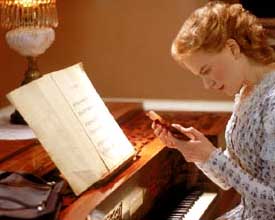 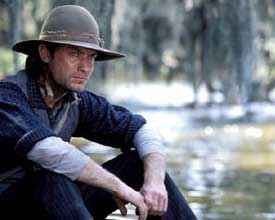 |
|
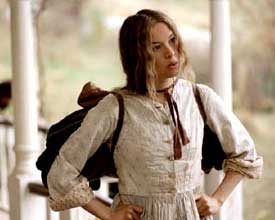 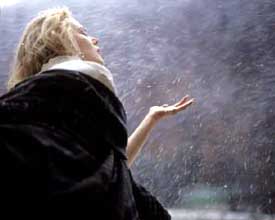 |
|
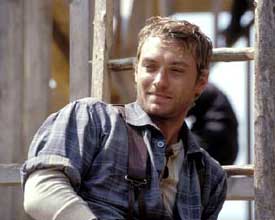 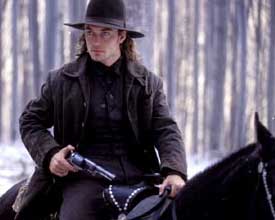 |
|
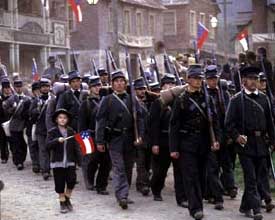 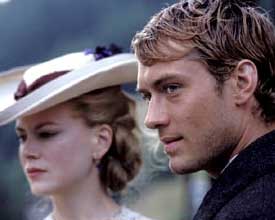 |
|
|
 |
|
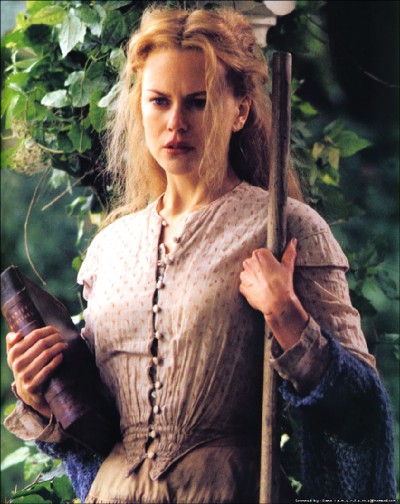 |
|
|
|
Fearing for the safety of his beloved Ada, the wounded Confederate
soldier Inman makes his way across the war-ravaged South, back to her
farm on Cold Mountain. He faces trials and tribulations as he
encounters slaves and bounty hunters, soldiers and witches, unexpected
friends and dangerous enemies at every turn. Ada's road is no easier
as she relies on wits and newfound bravery to protect her father's
farm from attack, with the help of an intrepid drifter named Ruby.
As they come ever closer, Inman and Ada
weave a story about the longing for home after being in the
wilderness, the longing for peace after being at war, and the longing
for love and union in the midst of chaos.
Based on one of the most acclaimed novels in recent memory, "Cold
Mountain" sets off on a true American odyssey through a time that saw
some of the greatest ferocity -- and heroism -- the nation has ever
known.
|
THE
TIMES - January 11 2004
|
|
|
MARK EDWARDS
|
VARIOUS ARTISTS
Cold
Mountain OST
Columbia
5151192
ONCE part of the mighty phalanx of guitarists that backed
Bob Dylan on his revered Rolling Thunder tour, T Bone Burnett
is best known now for masterminding the soundtrack to O
Brother, Where Art Thou?. Burnett has found his niche,
following up O Brother with the equally wonderful Cajun-tinged
soundtrack to Divine Secrets of the Ya-Ya Sisterhood, and now
a mix of blues, folk and gospel for the civil-war movie Cold
Mountain. The bait for music fans here is the presence of Jack
White on four songs, and he acquits himself well, but, though
White may lure you in, the real find here is the Sacred Harp
Singers -- an untrained gospel choir whose I'm Going Home will
raise the hairs on the back of your neck.
Two stars
|
 |
THE OBSERVER - January 11
2004
|
Pop CD of the Week:
Roots manoeuvres: Various: Cold Mountain OST
|
KITTY EMPIRE
|
VARIOUS
Cold
Mountain OST
Columbia
....... Cold Mountain's soundtrack boasts a brace of eerie
revamped traditionals and a few uneasy new compositions.
Its chief pleasures lie in the presence of The White Stripes'
Jack White, no stranger to role-playing, or convincing reanimations
of old musics. He slips with ease into the skin of
Georgia, a Civil War soldier and banjo-strummer, and his
unshowy and fragile renditions of classics like 'Wayfarin'
Stranger' feel utterly convincing. Chills, too come from
Cassie Franklin's performance of the bleak 'Lady Margret', and
the Sacred Harp Singers' vaulting a cappellas. But
bluegrass queen Alison Krauss disappoints, coming over too
breathy and girly for the prevailing atmosphere of hardship. Sting's new song for her
misfires badly, too. With one exception - Jack White's
excellent 'Never Far Away', which tackles folk via the
countryfied meditations of Led Zeppelin - it is, ironically,
the unvarnished, ancient stuff that rings the truest here. |
|
|
|